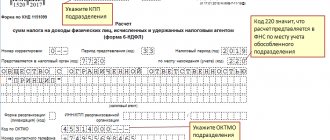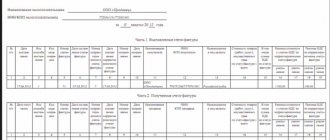What taxes and where does the separate division pay?
Personal income tax
Tax on personal income calculated from the salaries of employees must be paid to the budget of that region and to the details of the tax office in which the OP is registered.
If, in the event of an error, the personal income tax for the OP was transferred to the budget of the parent company, this circumstance is not an error.
Reporting The personal income tax register is also submitted to the tax office at the location of the separate subdivision.
Insurance contributions to the Pension Fund, Social Insurance Fund and reporting to funds
In order for an OP to pay insurance premiums to territorial funds at the place of registration of a separate division and submit reports to these divisions, the following conditions must be simultaneously met:
- availability of a separate OP balance;
- presence of a separate current account of the OP;
- independent payroll processing by a separate department.
If a separate division independently pays insurance premiums to the territorial branch of the OP, then reporting to the Pension Fund of the Russian Federation and the Social Insurance Fund is submitted at the place of registration of the separate division.
VAT
Value added tax (VAT), regardless of who issued the invoice (the parent company or a separate division), is paid by the parent company.
The VAT return is submitted to the Federal Tax Service of the parent company.
Income tax
Advance payments and income tax are paid as follows:
- to the federal budget: at the location of the parent organization;
- to the regional budget: at the location of the parent organization and each separate division.
The income tax return is submitted by the parent organization, taking into account the data on the OP.
Based on Order of the Federal Tax Service of Russia dated March 22, 2012 No. ММВ-7-3/ [email protected], the profit declaration is filled out as follows:
Appendix No. 5 to Sheet 02 is filled out by the taxpayer for an organization without separate divisions and for each separate division.
The number of Appendices 5 to Sheet 02 depends on the number of separate divisions.
Property tax
If a separate division has its own balance sheet, then property tax must be paid to the budget of the region where the separate division is registered.
If a separate division does not have a separate balance sheet, then property tax must be paid to the budget of the region where the parent organization is registered.
If a separate subdivision has its own balance sheet, then the Property Tax Declaration is submitted to the territorial tax office of the separate subdivision.
If a separate division is not allocated to a separate balance sheet, then the Property Tax Declaration is submitted to the territorial tax office of the parent company.
Transport tax
The transport tax declaration, like the tax, must be submitted and paid at the location of the vehicles, if the organization is not the largest taxpayer.
simplified tax system
Payment of tax according to the simplified tax system is carried out at the place of registration of the parent organization. Books of income and expenses are formed jointly with the parent and separate organization.
The declaration according to the simplified tax system is submitted to the territorial tax office of the parent organization.
How do separate divisions affect the taxation system?
One of the most unpleasant restrictions for companies using a simplified taxation system is the inability to open branches (subparagraph 1, paragraph 3, Article 346.12 of the Tax Code does not talk about other types of divisions, including representative offices).
If you create such an OP in the middle of the year, then the simplifier is obliged to start using the general system. However, some organizations, on the contrary, turn this point to their advantage. For example, a company is offered a lucrative contract using the simplified tax system, but the client is ready to work with it only if VAT is available. Then a branch is opened, the company loses the right to use the simplified tax system and switches to OSNO.
Important! The creation of a separate division must be realistic. It must not only exist on paper, but also have a staff, a current manager, an actual address and conduct activities.
It should be noted that if the Federal Tax Service finds signs of formality of the action, then there is a high chance of recognizing the maneuver as deception. For the purpose of obtaining tax benefits, including. You will have to recalculate taxes, pay penalties, resubmit reports, and the client will not be happy.
As for UTII, some questions arise here too. An organization has opened a new store, is it necessary to register if it is located in the same city as other existing retail outlets? The answer is in paragraph 2 of Art. 346.28 of the Tax Code of the Russian Federation: if the activity is carried out in different city districts, municipal areas, in intra-city territories and at the same time they are served by different branches of the Federal Tax Service, then you need to register with one of the inspectorates (the one that has jurisdiction over the first place of activity in the application).
If we are talking about different municipalities, then you need to submit an application in each (only once, and then proceed as described above). You will also have to submit a UTII-2 application if the organization starts a new type of activity on the imputation.
Profit share of a separate division
Payment of taxes and advance payments is made based on the share of profit. To calculate it, one of two indicators is taken as the basis:
- average number of employees of the EP (hereinafter referred to as SCOP);
- expenses for remuneration of employees of the OP (hereinafter referred to as OTOP).
The selected indicator, according to Article 288 of the Tax Code of the Russian Federation, is reflected in the accounting tax policy. The decision to make changes to tax policy is made from the beginning of the tax year. This is stated in Article 313 of the Tax Code of the Russian Federation.
The calculation of the profit share for the OP is carried out in accordance with a certain algorithm:
Calculation of the specific gravity of the selected indicator - SCHOP or OTOP Specific gravity SCHOP = SCHOP / SCHORG * 100%
or
Share of OTOP = OTOP / OTORG * 100%, where SCHORG and OTORG are indicators for the organization as a whole.
Calculation of the share of the residual value of the depreciable property of the OP (hereinafter referred to as OSOP)
Share of OSOP = OSOP / OSORG * 100%, where OSOP is the residual value of the organization’s depreciable property.
Calculation of the profit share of a separate division (hereinafter referred to as DPOP)
DPOP = (Share of SCOP + Share of OSOP) / 2
or
DPOP = (Share of OTOP + Share of OVOP) / 2.
How to calculate the share of profit for a separate division - it is advisable to give an example in the tax policy or in other documentation of the organization.
Note that when choosing an indicator of labor costs to calculate the share of profit, it is necessary to take into account the costs of wages for employees who are not part of the company’s staff and who work on the basis of civil contracts and contract agreements.
Branch tax reporting
A branch is a separate division of a company that is located outside its location and carries out its functions. In turn, according to Article 11 of the Tax Code, a separate subdivision is understood as any territorially separate subdivision at the location of which stationary workplaces are equipped. In this case, a workplace is considered stationary if it is created for a period of more than one month. Please note: a branch is not a legal entity. He only receives property from the company that created it and acts on the basis of the provisions approved by it.
So, a branch is a separate division of a company. True, there is some difference between these concepts. The branch must be indicated in the constituent documents of the company (Article 55 of the Civil Code). This requirement does not apply to a separate division. Despite this, the company is required to register with the tax office at the location of each separate division (and therefore the branch). This is stated in paragraph 1 of Article 83 of the Tax Code. Some managers are wondering, if only one workplace is organized outside the location of the organization, is it necessary to register for tax purposes in this case? This problem follows from the content of paragraph 2 of Article 11 of the Tax Code. It says here that one of the conditions for recognition of a separate unit as such is the presence of equipped stationary workplaces. One gets the impression that if only one place is equipped, then there is no need to register. Let us note that the courts were of the same opinion. For example, the arbitrators of the Federal Arbitration Court of the Moscow District (see resolution of October 3, 2001 No. KA-A40/5441-01) recognized the provisions of paragraph 2 of Article 11 of the Tax Code as “unclear”. Therefore, they supported the position of the company, which did not register for tax purposes at the location of a separate division where only one person worked. However, as time passed, the judges' views changed. Now they believe that registration is mandatory even if only one workplace has been created in a separate division. For example, the arbitrators of the Federal Arbitration Court of the Moscow District came to this conclusion (see resolution of January 23, 2003 No. KA-A41/9052-02). Let us note that the position of the tax authorities regarding the registration of a separate division remains unchanged. In their opinion, such an obligation does not depend on whether one or more workplaces are equipped (see letter of the Ministry of Taxation dated April 29, 2004 No. 09-3-02/1912). Currently, the procedure for registering separate units is regulated by order of the Ministry of Taxes of March 3, 2004 No. BG-3-09/178. To register a branch, you need to submit an application to the inspectorate at its location in form No. 09-1-1. This form is given in Appendix 2 to the order of the Ministry of Taxes. This must be done within a month (clause 4 of Article 83 of the Tax Code) from the moment when workplaces are equipped in the branch and it begins its activities. The branch is not a tax payer, unlike the parent company. He can only fulfill the duties of his parent company in paying certain taxes. And in such cases, the branch must submit tax returns to the tax office at its location. The total amount of income tax for the entire company, together with its branches, is paid by the parent company itself (Article 288 of the Tax Code). At the same time, it does not distribute the amounts payable to the federal budget and pays in a single payment. And the tax attributable to regional and local budgets is transferred separately to the place of its registration and to the place of registration of the branch. In accordance with paragraph 1.5 of the Instructions for filling out the income tax return (approved by order of the Ministry of Taxes and Taxes dated December 29, 2001 No. BG-3-02/585), at the place of registration of the branch, you must submit a declaration consisting of: – title page; – subsection 1.1 and (or) subsection 1.2 of Section 1; – appendix 5a to sheet 02 with the amount of tax that is paid at the location of the branch. The declaration must be submitted to the tax authorities no later than 28 days from the end of the reporting period, that is, no later than July 28. If a branch is allocated to a separate balance sheet and has taxable property, then the parent company must pay tax for it at the location of the branch (Article 384 of the Tax Code). In this case, a calculation of advance payments should be submitted to the tax office at the location of the branch, consisting of: – a title page; – section 1; – section 2; – section 4 with the value of the taxable property of the branch and the amount of tax for the branch; – Section 5 if the branch has tax-free property. The branch must submit calculations for advance payments for the first half of 2004 no later than July 30. The parent company must pay VAT and report on it. She pays the entire amount of tax without breakdown by division according to the details of her tax office (clause 2 of Article 174 of the Tax Code). The company must also submit a consolidated declaration at the place of its registration (clause 5 of Article 174 of the Tax Code). The company is not required to submit reports to branch inspection offices. If a branch is allocated to a separate balance sheet, has its own current account and pays salaries to employees, then it fulfills the obligation to pay the Unified Tax for its parent company (clause 8 of Article 243 of the Tax Code). In all other cases, the UST for the branch must be paid by the parent company. A branch that independently pays the Unified Tax must report this tax to the tax office at its place of registration. When calculating advance payments under the UST, he must indicate only his own tax amount. The parent company also fills out the calculation only for its accruals, but at the same time it additionally fills out the section where it indicates the Unified Tax for each branch. Please note: regardless of how the company pays the UST, it must calculate the conditions for the right to apply regressive rates to the organization as a whole. Calculations for advance payments under the UST must be submitted no later than July 20, 2004. A similar reporting procedure is provided for contributions for compulsory insurance against accidents and occupational diseases. The procedure for paying pension contributions is established in the Law of December 15, 2001 No. 167-FZ “On Compulsory Pension Insurance in the Russian Federation”. According to it, the parent company must transfer contributions to the location of the branch from its current account, even if the branch has a balance, account and pays salaries to employees. This is inconvenient, since the unified social tax in such situations is paid by the branch itself. Officials met the companies halfway and issued a joint letter from the Ministry of Taxes and the Pension Fund of June 11 and 14, 2002 No. BG-6-05/835. In it, they allowed branches that themselves pay UST to independently transfer insurance contributions to the Pension Fund. Reporting on contributions is presented in the same way as reporting on the Unified Social Tax. If a branch pays contributions, then it submits calculations for advance payments only on its own amounts, and the parent company - only on the amounts that it pays. At the same time, the parent company presents the calculation of pension contributions for the organization as a whole and broken down by branches. Calculations for advance payments of insurance premiums for compulsory pension insurance must be submitted no later than July 20, 2004.







